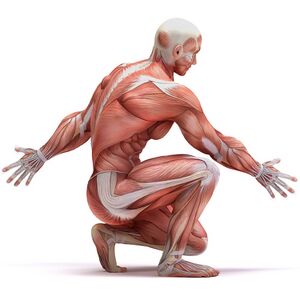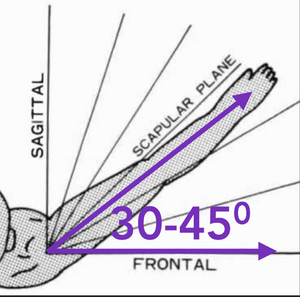Ergonomics for Daily Life
Top Contributors - Nuriena Vang, Sommern Willie, Kim Jackson, Brooke Coleman, Alicia Fernandes, Olajumoke Ogunleye and Cindy John-Chu
Introduction[edit | edit source]
Ergonomics are an important factor when establishing an environment that provides optimal productivity.
Three types of ergonomics include
- cognitive-Cognitive ergonomics is centred around the mental aspect that plays a role in ergonomics.
- organizational-Organizational ergonomics pertains to the importance of having a sound structure within a social-technical system. This includes organizational structures, policies, and processes
- physical-Physical ergonomics is geared towards ergonomics used in the workplace and deals with musculoskeletal disorders possibly associated with the workplace. Understanding the importance of physical ergonomics contributes to optimizing your approach to day-to-day operations.
Physical Ergonomics[edit | edit source]
Understanding the intricacies of ergonomics is paramount in establishing environments that promote optimal productivity and overall well-being. In this article, we will delve into the realm of physical ergonomics, a domain where your expertise as a physiotherapist holds significant weight, exploring its importance in daily life and providing evidence-based insights.
Physical ergonomics entails a comprehensive evaluation of the human body, considering its anatomy, physiology, and anthropometry. As a physiotherapist, you're well aware of how these factors contribute to understanding structure, motion, function, and performance, all of which play a crucial role in evaluating and addressing body mechanics and posture.
The Importance of Applying Physical Ergonomics in Daily Life[edit | edit source]
A pertinent question to ask in the application of physical ergonomics…What is the importance of applying physical ergonomics in daily life?
Habits of postural stress, poor posture, body mechanics, and/or even clothing choices over a period of time may lead to musculoskeletal injuries/disorders (MSK disorders).[2] A few common examples of MSK disorders caused by poor habits in the workplace include: low back pain, carpal tunnel syndrome, neck pain, and/or shoulder stiffness.[3]
A concept to consider and appreciate is that the human body does not only move primarily in the sagittal and frontal plane to complete daily activities, but also in the transverse and scaption plane.
For example, a cashier might coordinate a slight twist of their trunk to grab groceries to scan and then bag the items while a stocker might twist their trunk and move in the scaption plane to restock pasta boxes on a shelf. Setting the human body in a position that optimizes movement would be critical to reducing the chances of developing MSK disorders. Below are a few examples of daily activities with consequences that may lead to MSK disorders and how we can refine those activities.
Ergonomics of Daily Life[edit | edit source]
Driving:
- Technique to improve: adjust mirrors, lift seat at the right height, backrest adjustment, headrest position [5]
- Consequences: poor vibration attenuation, poor postural support leading to hunching, increased stress and headaches[6]
Bathroom hygiene: [8]
- Technique: Position toiletry items where they are easily accessible, check the lighting in the bathroom, and adjust the height of the sinks .[9]
- Consequences: Neck & back pain, falls / injuries.
Typing and computer work:[10]
- Technique: Ergonomic keyboard, standing desk, proper postural orientation, taking breaks.
- Consequences: Neck pain, tension & stress, carpal tunnel syndrome.
Phone:[11]
- Technique: Neutral spine alignment, limiting time and messaging, increasing voice commands, taking persistent rest breaks, avoiding holding the phone below chest height. [12][13]
- Consequences: neck pain and ache, tension & stress, aching in the fingers, visual strain and headaches.
Case study[edit | edit source]
Case Study 1: Office Ergonomics Intervention[edit | edit source]
Patient Profile:
- Name: Mr. Sharma
- Occupation: Software Developer
- Chief Complaint: Chronic neck and back pain due to prolonged computer use.
Intervention:
- Implemented ergonomic changes to Mr. Sharma's workstation, including an adjustable chair, ergonomic keyboard, and regular breaks for stretching exercises.
- Conducted education sessions on maintaining proper posture during computer work.
Outcome:
- Significant reduction in neck and back pain.
- Improved work productivity and job satisfaction..[14]
Case Study 2: Driving Ergonomics for a Cab Driver[edit | edit source]
Patient Profile:
- Name: Ms. Patel
- Occupation: Taxi Driver
- Chief Complaint: Lower back pain and stiffness after long hours of driving.
Intervention:
- Adjusted the driver's seat for proper lumbar support.
- Taught specific stretching exercises to be performed during breaks.
- Emphasized the importance of regular posture checks during driving.
Outcome:
- Reduced lower back pain and stiffness.
- Improved awareness of ergonomic practices while driving.[15]
Case Study 3: Home Office Ergonomics[edit | edit source]
Patient Profile:
- Name: Ms. Khan
- Occupation: Freelance Writer
- Chief Complaint: Shoulder and wrist pain related to extended periods of typing at a makeshift home office.
Intervention:
- Provided recommendations for an ergonomic desk and chair setup.
- Suggested the use of an ergonomic keyboard and mouse.
- Taught specific exercises to prevent and alleviate shoulder and wrist pain.
Outcome:
- Reduction in shoulder and wrist pain.
- Increased productivity in a comfortable home office environment.[16]
Professional Tips and Tricks for Physiotherapists[edit | edit source]
1. Comprehensive Assessment:
- Conduct a thorough assessment of the patient's work environment, considering both physical and psychosocial factors.
- Personal Insight: In my experience, addressing the root cause requires a holistic view of the patient's daily activities, not just the immediate symptoms.[17]
2. Tailored Exercise Programs:
- Design personalized exercise programs focusing on strengthening and stretching specific muscle groups affected by poor ergonomics.
- Personal Insight: I've found that empowering patients with targeted exercises fosters an active approach to maintaining musculoskeletal health.[18]
3. Educate on Proper Posture:
- Provide education on maintaining correct posture during daily activities, emphasizing the importance of spine alignment.
- Personal Insight: Integrating simple, relatable explanations of posture can resonate well with patients. I often use humor to make it more engaging.[19]
4. Utilize Ergonomic Tools:
- Recommend ergonomic tools such as chairs, keyboards, and mouse devices tailored to the patient's specific needs.
- Personal Insight: I've seen remarkable improvements when patients incorporate ergonomic tools into their daily routines, enhancing comfort and functionality.[20]
5. Encourage Breaks and Movement:
- Advocate for regular breaks and movement, especially for those with sedentary jobs, to prevent stiffness and discomfort.
- Personal Insight: Small, frequent breaks can make a significant difference. I often suggest simple stretches that can be done at the desk.[21]
6. Continuous Communication:
- Maintain open communication with patients to monitor progress and address any emerging issues promptly.
- Personal Insight: Regular check-ins help build a rapport, making patients more receptive to ergonomic adjustments and lifestyle changes.[22]
By incorporating these tips into your clinical practice, you can create a more personalized and effective approach to ergonomic interventions, fostering positive outcomes for your patients.
References[edit | edit source]
- ↑ Human Body: Muscular System Review | Carolina.com
- ↑ PainScience. Does Posture Matter? A detailed guide to posture and postural correction strategies (especially why none of it matters very much). Available from: https://www.painscience.com/articles/posture.php (accessed 2 April 2022).
- ↑ Samad, M. A. Ergonomics and the Prevention of Musculoskeletal Strain and Back Injuries. International Journal of Engineering and Advanced Technology (IJEAT). 2017;6:40-43.
- ↑ Reinventing the Shoulder - Blog (core advantage.com.au)
- ↑ US Department of Agriculture: Animal and Plant Health Inspection Service. Driving Ergonomics. Available from: https://www.aphis.usda.gov/aphis/ourfocus/emergencyresponse/emergency_management/ergonomics_program/driving-ergonomics#:~:text=Driving%20ergonomics%20has%20an%20overall,sitting%20and%20standing%20jobs%2Factivities (accessed 13 April 2022).
- ↑ Reference: O'Sullivan, P., Dankaerts, W., Burnett, A., Straker, L., Bargon, G., & Moloney, N. (2011). Lumbar posture and trunk muscle activation during a typing task when sitting on a novel dynamic ergonomic chair. Applied Ergonomics, 42(1), 61-68.
- ↑ Brooke Coleman. Driving Ergonomics. Available from: https://www.youtube.com/watch?v=DjviJ9MNxdI [last accessed April 18, 2022]
- ↑ APTA. (2020). "Ergonomics: Safe Patient Handling Toolkit." American Physical Therapy Association. The APTA's toolkit provides evidence-based guidelines on safe patient handling, which can be extrapolated to recommendations for optimizing activities such as bathroom hygiene.
- ↑ Modobath. How an Ergonomic Bathroom Can Improve your Health. Available from: https://www.modobath.com/inspiration/how-an-ergonomic-bathroom-can-improve-your-health/ (accessed 13 April 2022).
- ↑ Hedge, A. (2004). Effects of an adjustable chair and office ergonomics training on the discomfort of VDT users. Ergonomics, 47(2), 172-186. This study explores the impact of ergonomic interventions, including adjustable chairs, on reducing discomfort during computer work.
- ↑ Straker, L., Coleman, J., Skoss, R., Maslen, B., Burgess-Limerick, R., & Pollock, C. (2008). A comparison of posture and muscle activity during tablet computer, desktop computer and paper use by young children. Ergonomics, 51(4), 540-555. This study investigates posture and muscle activity during various forms of screen use, offering insights into optimal ergonomics for phone usage.
- ↑ UCLA Health. Ergonomic Tips For The Use Of Hand-Held Devices. Available from: https://www.uclahealth.org/safety/Workfiles/Ergo-Tips-Hand-Held-Devices.pdf (accessed 13 April 2022).
- ↑ PhysioAdvisor. Mobile Phone Ergonomics. Available from: https://physioadvisor.com.au/health/ergonomics/mobile-phone-ergonomics#:~:text=Try%20to%20maintain%20the%20phone,body%20with%20the%20neck%20rotated (accessed 13 April 2022).
- ↑ Hedge, A. (2004). Effects of an adjustable chair and office ergonomics training on the discomfort of VDT users. *Ergonomics, 47*(2), 172-186.
- ↑ O'Sullivan, P., Dankaerts, W., Burnett, A., Straker, L., Bargon, G., & Moloney, N. (2011). Lumbar posture and trunk muscle activation during a typing task when sitting on a novel dynamic ergonomic chair. *Applied Ergonomics, 42*(1), 61-68
- ↑ Straker, L., Coleman, J., Skoss, R., Maslen, B., Burgess-Limerick, R., & Pollock, C. (2008). A comparison of posture and muscle activity during tablet computer, desktop computer and paper use by young children. *Ergonomics, 51*(4), 540-555.
- ↑ Samad, M. A. (2017). Ergonomics and the Prevention of Musculoskeletal Strain and Back Injuries. *International Journal of Engineering and Advanced Technology (IJEAT), 6*(6), 40-43.
- ↑ PhysioAdvisor. Mobile Phone Ergonomics. Available from: https://physioadvisor.com.au/health/ergonomics/mobile-phone-ergonomics#:~:text=Try%20to%20maintain%20the%20phone,body%20with%20the%20neck%20rotated.
- ↑ PainScience. Does Posture Matter? A detailed guide to posture and postural correction strategies. Available from: https://www.painscience.com/articles/posture.php
- ↑ Reinventing the Shoulder - Blog (coreadvantage.com.au)
- ↑ Modobath. How an Ergonomic Bathroom Can Improve your Health. Available from: https://www.modobath.com/inspiration/how-an-ergonomic-bathroom-can-improve-your-health/
- ↑ APTA. (2020). "Ergonomics: Safe Patient Handling Toolkit." American Physical Therapy Association.








